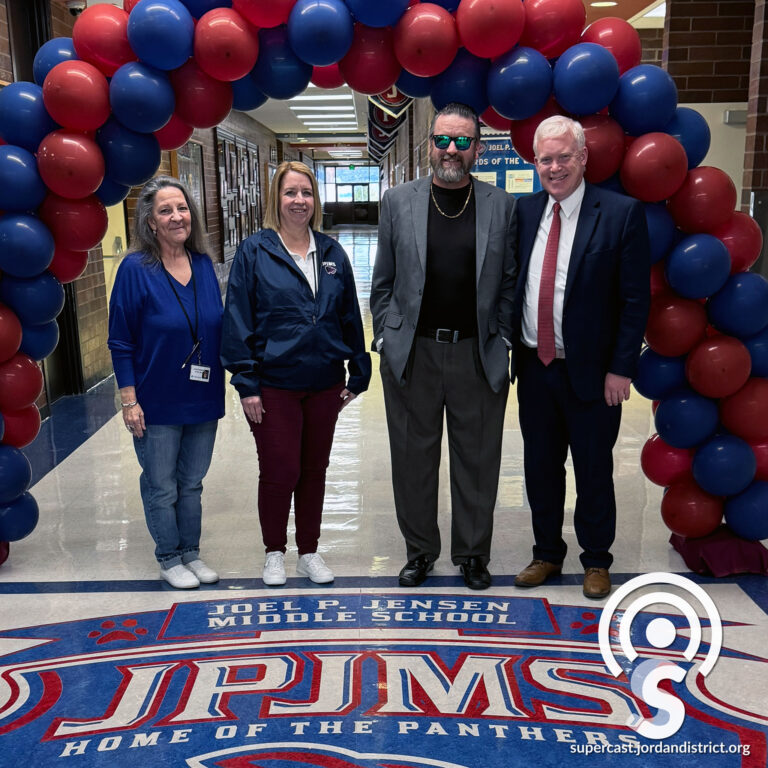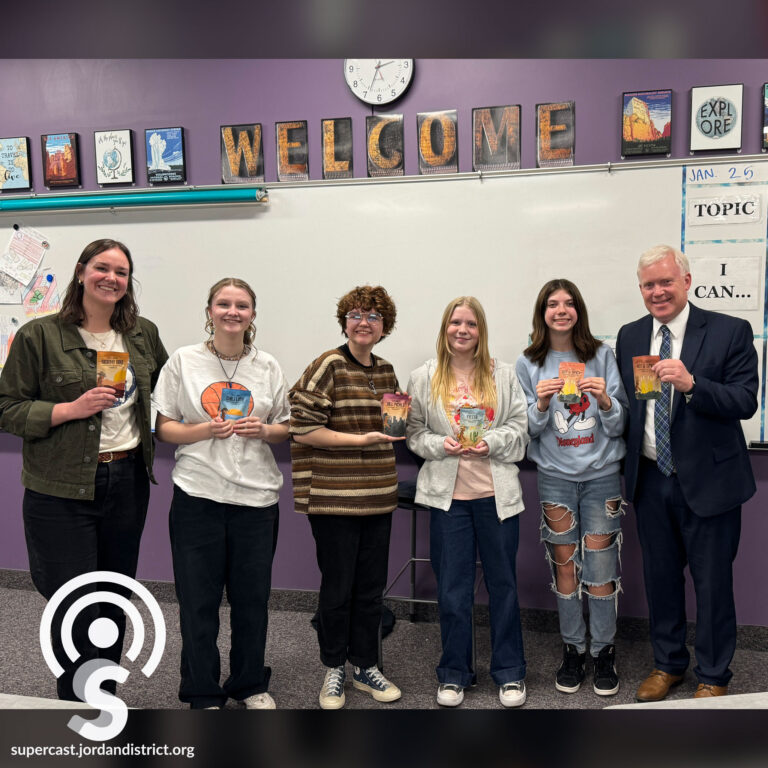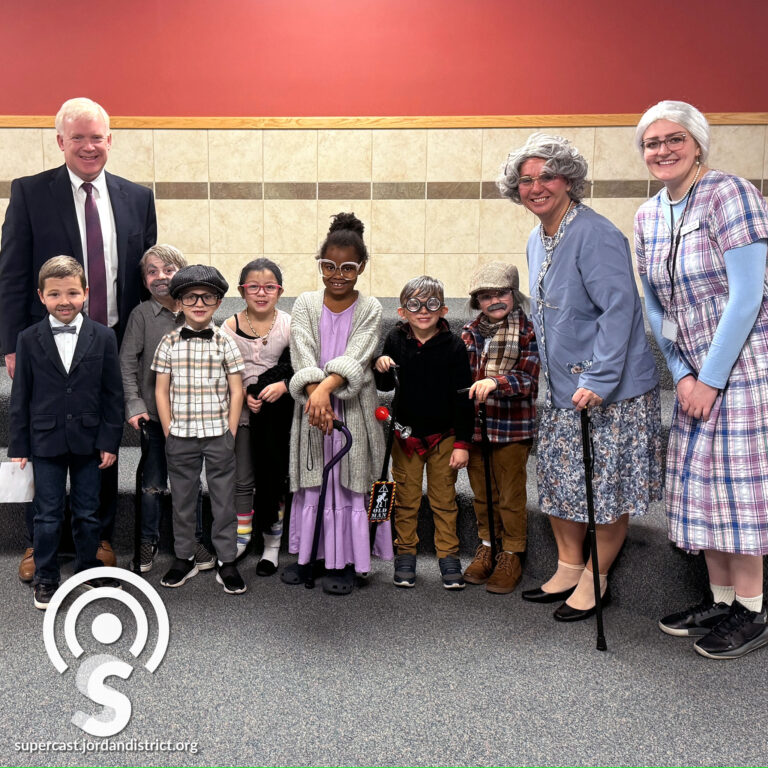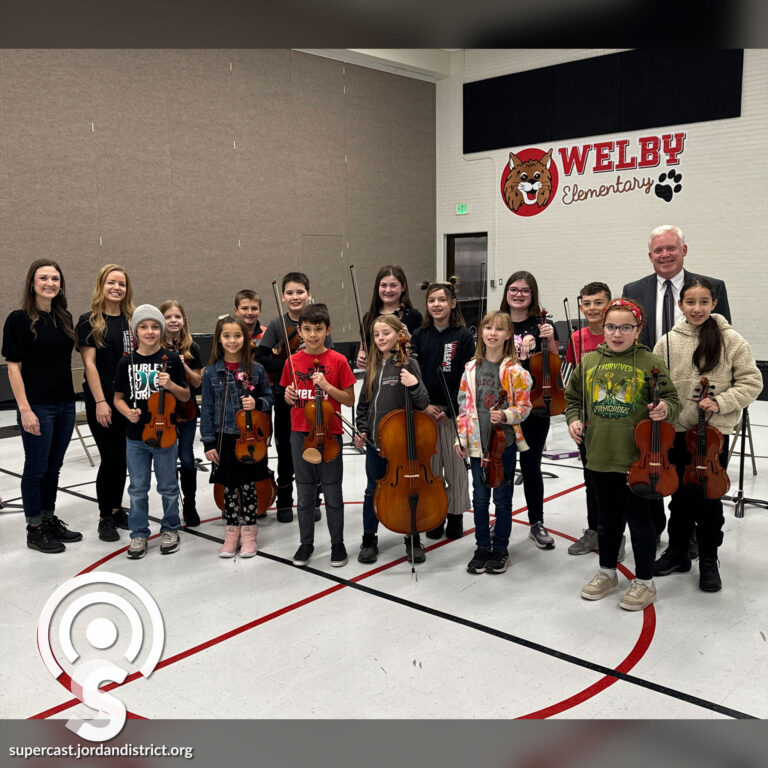It was an evening of fun traveling back in time to 1984 when Joel P. Jensen Middle School first opened its doors. Joel P. Jensen recently threw a big birthday bash to commemorate four decades of being a part of the community.
On this episode of the Supercast, we take you inside the 80’s style party where everyone was having fun celebrating 40 years of history, making memories, building friendships, and educating students.
Audio Transcription
[Music]Anthony Godfrey:
Hello and welcome to the Supercast. I'm your host, Superintendent Anthony Godfrey. It was an evening of fun traveling back in time to 1984 when Joel P. Jensen Middle School first opened its doors. Joel P. Jensen recently threw a big birthday bash to commemorate four decades of being at the heart of their community.
On this episode of the Supercast, we take you inside the 80s style party where everyone was having fun celebrating 40 years of history, making memories, building friendships, and educating students.
[Music]We are here at Joel P. Jensen celebrating 40 years of Joel P. Jensen. It's an exciting time. Introduce yourselves and tell me about your relationship with Joel P. Jensen, the middle school, not the man, and how long you have been here.
Aaron Hunter:
Aaron Hunter, principal, off and on at Joel P. for a decade, 10 years.
Anthony Godfrey:
Tell me about the offs and the ons.
Aaron Hunter:
So I started my admin career in Jordan District at Joel P. I was an assistant principal here for six and a half years and then two years ago came back as principal.
Anthony Godfrey:
A triumphant return to everyone's delight that they got to have Aaron Hunter back in their lives.
Aaron Hunter:
It's a great place to be.
Anthony Godfrey:
And you have done a great job of promoting Joel P. Jensen and the great things that are happening here, which we'll get back to in just a moment. But let's take a trip through memory lane and talk with a couple of employees who've been here for a while.
Deb Atkinson:
I'm Deb Atkinson. I'm the head secretary. I've been here for a really, really long time. This is 26 and a half years so far.
Anthony Godfrey:
26 and a half years.
Deb Atkinson:
I had one little break in between where I got bumped to the district office and I was in Info Systems for 13 months and then I interviewed and came back to my school.
Anthony Godfrey:
You knew where you needed to be. Okay, we'll get back to some stories from you. Tell me about your time here at Joel P. Jensen.
Suzie:
My name is Suzie. I started 25 years ago. I started in the ISS room. Steve Crowther hired me. I was there for a while then they asked me to be a hall monitor. I was that until we went under numbers. So then they said that I had to not do a hall monitor, but I didn't want to leave because I liked Joel P. so much, so I stayed as a tracker. And then when numbers went back up, I came back to the hall monitor and then they went to the part-time stuff. I hung out with that and then I kind of retired until this lovely gentleman over here called me and said would you come back? For some reason, I said yes, probably because I love Joel P. So I came back and so I've been back for the last year and a half.
Anthony Godfrey:
So this is really a pattern for all three of you. You leave, you come back. And for you you leave and you come back and you leave and you come back.
Suzie:
Yeah, it was like I can't describe it. There's– Joel P. is just different. The kids are different. I love it. I missed it. I tried somewhere else a long time ago and it's just not the same.
Anthony Godfrey:
As Al Pacino says ‘They keep pulling you back in.’
Suzie:
He pulled me back in and she's amazing so to work with. The two of them have just been– it's just really cool. It's a good relationship. I really like it and the kids. I mean there are no other kids like Joel P. kids. They just climb into your heart and they hang out there. And then they come back and see you, and then they bring their kids to register which makes him feel older. I'm fine.
Anthony Godfrey:
So you've had multiple generations of kids here at Joel P. Jensen that you've worked with.
Deb Atkinson:
Some this year that we have the parents that were like “Hey, I remember you. You were here.”
Suzie:
And then they go “These are our kids” and then they go “and you're still here.”
Anthony Godfrey:
But see if they can remember you after 25 years that's a really high compliment to you that you've been able to be recognizable after that many years. Tell me what is it about Joel P. Jensen kids that you love, and I'm going to have each of you answer that. What is it that makes this place special when it comes to the students?
Suzie:
There are so many different– just diversity in these kids but they all get along together. They're just– to me, it's just, I don't know. You walk into Joel P. and it's so different but they're so much the same. They're like no other kids. I don't know. I can't explain it. They need you. Joel P. kids need you and Joel P. kids let you know that they truly need you. You come in here and I see all these mini-me's because I struggled. I mean I went to Kearns High and I was not the best student. I’ll own it. That's why I'm really good at what I do. But the kids that are here– I mean, you walk in and you know they care and you know they need you. These kids just crawl into your heart and they stay there.
We've gone through a lot of admin together me and Deb. We've had a lot of teachers we've gone through. And some of the admin crawl into your heart and they stay, but Joel P. you're just– I don't know I can't describe it but we keep coming back. It's like you can feel truly that they need you and it just– I get a little emotional about it so it's Deb’s turn.
Deb Atkinson:
Well, I just love the fact that they're so unpredictable. So when you feel that you've seen whatever one student is going to do, you’re like “Okay I've seen it all now” and then they come up with another fun thing that you're going like “Okay, this is why I come back every day because they make it great.”
Anthony Godfrey:
Yeah, it's true, if anywhere in the district is full of surprises it's middle schools. You never know what your day is going to bring. I miss middle– I started out as a middle school teacher at Bingham Middle School and then at West Hills. I love the middle school age and like you said Joel P. Jensen is unique even within the middle school group because of the the kids that you have here and the real sense of belonging that you create here. I've known that for a long time. Tell me about the students here Aaron.
Aaron Hunter:
Yeah, it's been said, but it really is a special place. People laugh when I say it's the best school in the state, but I really, truly do believe that. I think a lot of our kids outside of West Jordan are misunderstood. I think people– there's a certain stigma outside of our area of Joel P. and it's all wrong. I can tell you that 100 percent. Most of them need caring adults and that's why relationships are number one in our hearts. That's what drives our work here is those good relationships. There's nothing better than in June when they come back with a graduation announcement or “Hey, I'm working at Jiffy Lube”. You know, just great news of “Hey, you spent time, you took time out of your day to care about me and it means a lot.”
Anthony Godfrey:
Well, what I found, and this is very true of Joel P. Jensen, is that schools like this draw those caring adults because you don't survive if you don't care about kids. And so over time, over 40 years, the faculty just continues to attract caring adults that care at a deep level and make a personal connection with students like all of you have described. It's really rewarding to see as a Superintendent a school that functions like that.
Stay with us. When we come back more fun memories celebrating four decades of Joel P. Jensen Middle School.
Break:
Hello, I'm Sandy Riesgraf, Director of Communications for Jordan School District, and we want to invite you to connect with us. So many exciting things are happening in your child's school, your neighbor's school, in every school here, every day. Don't miss out on following the fun or simply staying informed when there's important information we need to share. Join us at jordandistrict.org, or follow us on Facebook, Twitter, and Instagram @jordandistrict. We can't wait to connect.
Anthony Godfrey:
Tell me about the faculty and the people who've worked here over the years. You've been here off and on over the last decade. We'll come back to Deb and Suzie. I'm sure they have a lot of stories about the people who've passed through here. Tell me about about those caring adults that you've worked with.
Aaron Hunter:
Well, you hit the nail on the head. I've been here a decade-ish, the teachers that stay are the teachers that– I don't want to say are the teachers that care because I think every teacher cares. I think everybody that goes into education, they care about kids.
Anthony Godfrey:
But there's an intense need for that different level of relationship here. If that's something that you're ready for then this is the type of place where you want to be.
Aaron Hunter:
Yep, and we and we foster that because this is a– I don't even want to say difficult. It's just our kids have different needs here. And so because of that fostering that sense of family is very important. I can't speak for everybody that works here, but I know me as a principal, my number one priority is to make sure that our teachers feel that they're supported to be their best selves. Because like you said middle school is hard. Joel P is sometimes hard and so we have that family aspect here where we can rely on each other. We can cry on each other's shoulders. We can get mad at each other. But at the end of the day, it's all because we love and care about kids. Our kids are never going to do the best on the state test scores and I fully know that as principal. But I can tell you one thing, they leave here knowing that they're fully taken care of and cared for.
Anthony Godfrey:
I like what you said about taking care of each other. It’s adults looking out for each other as well and supporting each other as you support the students. How about for you Deb?
Deb Atkinson:
Well, I think the faculty and staff they kind of have more of a family atmosphere where it's like we're all one group and we're all working together for the same goal. So that's what draws me to it. That's why I wanted to come back so bad because I just love the whole atmosphere, the people I work with. It was just great here, so that's why I wanted to come back. And I still love it. Anthony Godfrey:
There must be hundreds of faculty members you've worked with over 25 years.
Deb Atkinson:
Oh yeah.
Anthony Godfrey:
Yeah, that's really exciting. How about for you? What do you think Suzie?
Suzie:
Faculty-wise, if you stop and think about it, we had Connie Bailey here she was a PE teacher.
Anthony Godfrey:
Oh wow.
Suzie:
Who's now an admin. Cynthia VanderMeiden.
Anthony Godfrey:
Yeah.
Suzie:
She was a teacher here and then Todd was here for a while. We had Joanne Ackerman. She was a teacher and then an admin. Oh my gosh. Tim Heumann. I mean and the stories. Oh my goodness. He was a science teacher. Yep, yep. We'll just go on to the next one. Tim was a blast. Love, love Tim.
So yeah, I mean we've gone through a lot. We were talking about that. We figured 25 maybe admin, teachers are just tons, and then you figure kids average a thousand a year. That was 26,000 kids. It's just– I don't know it's always just been that unique school.
It's like I said when I came back. I wanted to be in a place where I wished I had– I wanted to be what I wished I had when I was at school. And that was my goal to make sure. Then you see teachers struggle here, so we do things like sneak down and put stuff on their desks and don't tell them where it came from. Just something that you know they like.
You know when I was a hall monitor, I would go help them out with their lovely students, my mini-me’s, that would be in there because you just support each other. There's no place like it. It's just really weird. I get to look back at Connie Bailey you know and Cynthia, remember those days with them, and boy the stories that you could go on for those. Me and Deb were thinking we could probably write a book one day when we retire officially and we don't come back.
Anthony Godfrey:
Well you never know that it will be permanent it sounds like. You could never count on that. Luckily, luckily you keep coming back.
Suzie:
I don't think so. I don't think it'll be permanent. As long as he's here and she's here for right now. They keep my sanity. I had a rough couple of years and they brought me back so you know it is what it is. You know, these kids that pop back in and see you and some of the teachers I run into, and then they say “Do you remember?” and I'm like “I do not recall that”.
Anthony Godfrey:
Yeah, you can only store so many stories up there. That's right. So when you're in this area of the district just driving around stopping for gas, shopping, whatever, I'm sure you run into some of those 25,000 people everywhere you go.
Aaron Hunter:
All the time. Yeah, all the time. Jordan Landing, O'Reilly Auto Parts down the street. And what's the most rewarding part of the job for me is, like I said, the goal is for our kids to at least reach it to high school and graduate. That's the goal. Unfortunately, for some of our kids, that doesn't happen. But it doesn't make it any less rewarding to see the kid working at O'Reilly that didn't graduate but is still a productive member of society and is doing his part. And “Hey Mr. Hunter do you remember me?” I mean, of course, I remember. You were in my office 70,000 times. So yeah, that's why we do what we do. I was told the other day that we think about these kids often but the kids that we impact think about us 10 times more than we think about them. That's pretty powerful.
Anthony Godfrey:
And you know, you're looking at how you can support them academically, of course, that's a very important goal. But you're supporting them in all kinds of other ways. How to manage the difficulties in their lives and how to find a pathway forward. Hopefully, that pathway includes graduation from high school, but credits are not the only thing that you take away from school when you have caring adults looking out for you. I think it's a great compliment when people say “Hey, remember me?” It's because they want to go back to those times and remember those times when they see you. That's because you've created memories and you've made the most of those moments with them.
Aaron Hunter:
Yep, yep, sure. Yeah, I mean like you said, as principal academics are obviously important. That's the number one reason you come to school is to learn. We tell kids that all the time. But the number two reason you come is to hang out with your friends and establish relationships. A lot of times with our kids that means more to them than the academic piece and that's why we love working here.
Anthony Godfrey:
Well, the sense of community makes the academics possible.
Suzie:
I live in West Jordan, closer than you think. So I live real close to West Jordan in a sense and I'm very very protective of Joel P. and I get really outspoken when people say things about Joel P.. I'm like “No, you need to be there to understand. Joel P. is a different type of school. What I enjoy is when the kids come back and say, let me see if I can word this right. “I'm sorry I was not nice to you. I'm sorry I said those things to you. But I want to tell you how much of an impact you made on us.” I had some parents who would come by and “Why do you work at that school?” Why not? If I could’ve had a Joel P. when I was growing up I wouldn't have gone the path I went in a certain amount of years.
Anthony Godfrey:
Tell me about today's celebration. 40 years is a big deal. I mean, I did the math. I could have been a seventh grader here the first year that Joel P. opened. That's how old it is now. So that's a long tradition of taking great care of everybody. Tell me about today's celebration.
Aaron Hunter:
Yeah, so 83-84 was the school year that Joel P. opened. This year with parent-teacher conferences our theme has kind of been to think outside of the box and to have a different spin on it. So we thought, what better time to celebrate 40 years? So tonight it's a big party. Everybody should come. Magicians, food, activities, booths, prizes, music, everything. It's going to be a big party.
Anthony Godfrey:
And because Joel P. Jensen opened up in the early 80s, it's an 80s theme tonight I understand.
Aaron Hunter:
Yes, 80s theme. I'm about ready to get my Miami Vice on right now as soon as we're done with this podcast.
Anthony Godfrey:
Well, it sounds like I need to stick around just a little bit longer then so I can make sure that I get to see that. I'm sorry I'm not wearing two Izod shirts with my collar popped.
Aaron Hunter:
You always can Superintendent.
Anthony Godfrey:
Yes. I could. I could.
Aaron Hunter:
It’s always a possibility. Slick back the hair-
Anthony Godfrey:
Yeah, that’s right. Peg the pants a little bit, yes.
Aaron Hunter:
–get some gold chains, no socks.
Anthony Godfrey:
Yeah, boat shoes. The list goes on.
Aaron Hunter:
Yes, pleated pants. I mean, it’s all in my closet.
Anthony Godfrey:
You are clearly a man of style. How about for you guys? Is your 80s wardrobe in the closet ready to go?
Suzie:
I could be his mom, so no. I could be probably everyone’s mom.
Anthony Godfrey:
Well, in a way you are, it sounds like. In a way, you are.
Suzie:
I am. You made it really clear. Yes, most of the assistant principals, my children are older than them. So I could be a grandma. You never know.
Anthony Godfrey:
Oh, that's awesome. In addition to all these great things about Joel P. Jensen, you are the only school with a middle initial. JPJMS it just kind of rolls off the tongue.
Anthony Godfrey:
That's right, JPJMS.
Suzie:
Today’s a good day, JPJ.
Anthony Godfrey:
Oh yeah.
Suzie:
See we've got all kinds of them.
Anthony Godfrey:
It rolls right off the tongue, it rolls right off the tongue. You're also the closest school to Dunford Bakery.
Suzie:
I know, straight up, seriously.
Anthony Godfrey:
How do you not stop for a cherry turnover every single morning?
Aaron Hunter:
I was going to say, we actually kind of do. There's no how do we not, we go to Dunford often. Anthony Godfrey:
Well, with the middle initial, and the donuts, and the caring people, and the great tradition of creating a community like this, permits are available for next year. If anyone's listening and thinking I need some Joel P. Jensen Middle in my life because it is a tremendous school with obviously, as you hear tonight, tremendous people. So thank you for taking such great good care of kids and taking such great care of each other.
Aaron Hunter:
Thanks, Superintendent.
Anthony Godfrey:
Thanks for joining us on another episode of the Supercast. Remember, education is the most important thing you will do today. We'll see you out there





